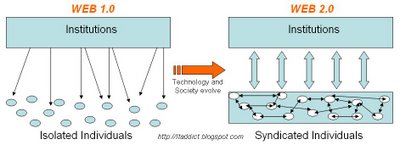From Web 1.0 to Web 2.0
I just tried to conceptualize the whole thing in a very simplistic chart. Tell me what you think about it!
Now, just one, very tellling example:
I co-founded 4 years ago, alongside with Jeremy Ghez - and joined at a later development stage by HEC-classmate Steve Danino, a think-tank on the Middle-East geopolitics: AFIDORA (see what Wikipedia says about this organization - in French).
a) AFIDORA.com, the Web 1.0 era
I had devised the first website myself: it was a homepage-like catalog of articles sorted by type (editorials, analyses, opinion, reports and synthesis). On the one hand, we were often praised for the quality of our research and event-organization capabilities; but on the other hand, though we were really willing to foster this aspect of our business, interesting interactions with our readership (including financial contributors, active members, guest speakers, etc.) hardly happened online. We were dealing with this issue (and this is very Web 1.0) by consolidating all our readers comments and our own reactions on a "Your Comments" space on the website.
It wasn´t so bad for the times, but we came to a point where new tools enabled better user interfaces and hence interactions...
2) AFIDORA.com, the Web 2.0 era
I was late (or lazy?) in realizing what we were about to miss if we didn´t upgrade our antique, old-fashioned website. Steve, already mentioned, felt the Web 2.0 tsunami ways before I did. He didn´t want AFIDORA to miss the comments democratization movement the Web 2.0 was impulsing. This movement was also so much AFIDORA!
The non-profit elitist think-tank (think-tank: a top-down approach that says "look, we are smarter than you, look at our great articles") was renamed "community on the Middle East geopolitics" (in a community, every member has the same rights) during the process of allowing readers to comment directly an article below it. Steve used the content management system Mambo and developed the new website alone for 2 months, every night.
Thanks to Steve Danino´s drive, AFIDORA.com now ranks number 4 in terms of single visitors in the whole French-speaking geopolitics and foreign affairs industry. You can visit AFIDORA´s Web 2.0 website by clicking here.


3 Comments:
Dear Jedi,
Many thanks for your FREE feedback on AFIDORA; it´s nice to have access to consultants through blogs. I´ll make sure the current management team gets to see your comments very soon so that they can improve the website.
Is there a way for our readers to contact you in case they need an estimate of how much you would charge them for suche a service?
By Jeremy Fain, at 6/29/2006 01:00:00 PM
Jeremy Fain, at 6/29/2006 01:00:00 PM
Hi everybody,
Being one of the main protagonist of the discussion above, it seems like it is my turn to talk…
JD, your comments are useful and welcomed. I will make sure that any further modification of the website takes this feedback into account.
Jeremy, once again, your natural fascination for anything new, smart and abstract has mislead you. By no means does AFIDORA 2.0 is a web 2.0 website. It never was, and it never intended to be indeed. I am afraid your all demonstration is pointless right now.
I’ll go further: Web 2.0 for now on, does not really mean anything characterized yet. It is a marketing trend, a gimmick for labelling some interesting technologies such as RSS, which are evolution – and no revolution – of the current web design generally accepted principles.
However, trying to explain the philosophy underlying my long walkabout in the jungle of the web design might prove interesting, especially for fellow afidorians. If by any chance, one of our team-mates finds this blog and takes the time to read carefully all our posts, he/she will see how thorough thinking was helpful before I undertook the burden of re-designing afidora.com.
First of all, and despite my deep-rooted reluctance to theorization, I must disclose my personal considerations about the Web and its evolution. I will be voluntarily very evasive. My only intention is to challenge your exposé, and show when necessary how the first version of Afidora was entrenched in an old-fashioned, obsolete vision.
Afidora 2.0, although totally independent from all the Web 2.0 buzz, was thought differently, in a much more modern way. Let’s see how.
___________________________________
Well then. In my opinion, what drove the success of the web was the fact that any isolated individual could project his work in a vast, open space. I suppose personal homepages or private ones such as many blogs or web galleries (aimed for friends/family/relatives) represent 90% or so of the total web.
At least this hypothesis seems logical. When the man in the street gets his first PC with internet access, one of his main concerns would be to exist in the network. Exist. That’s it. Exist, and not divulgate. Exist, and not communicate.
This means that even if he proposes content about a specific subject, his web page will suffer several drawbacks:
- Useability and readability: who was never tempted to design a webpage with a coloured or texture background, fizzy GIFs, nice Flash animations, music for the ambiance, etc… ? It is almost natural for a human being to look for the most flashy or attractive template in FrontPage, GoLive, RapidWeaver et al. Unfortunately, the comfort of the end-user (ergonomics) is always left behind. It took the web designers 8 – 10 years and the success of Google’s ascetic home page to understand that a white background and a sober interface actually attracted people in the end. Even if animated GIFs and 3D textures are nice-looking at a first glance, they are pointless, and Google understood that.
- Application to AFIDORA: you will find a snapshot of AFIDORA’s former website on www.archive.org. You will immediately see, that the blue/white - dotted background makes reading really painful. For AFIDORA 2.0, the whole thing was about being more open, and so accessible. Now, people can spend hours reading without feeling eye-tiredness.
- User-focused: what is a user-focused website ? It can mean many things, but I’d say that one of the most important feature a modern website can display is allowing the user to feel he has control on the website, and not that he receives passively information. It means:
1. offering feedback possibilities
2. displaying various accesses to information
3. displaying various forms of information
Application to AFIDORA: Feedback: it means that comments should be immediately available, un-moderated (yes, the author of in-depth analysis might yell to see their work illegitimated or insulted by John Doe, but it’s part of the game) and answered quickly. So instead of a centralized page, each articles deserves its comments, which are open –no registration there- and un-moderated. And they are answered as quickly as possible, despite the workload.
This is not an easy challenge, but AFIDORA 2.0 was designed for that. It is not a technology, it is a concept.
Besides, a poll section was added. It is a gadget, yes indeed, but it means people feel like living in a community and having their say. You just always feel curious about the results, and you enter in the game spontaneously.
In the same time, a search engine was implemented thanks to the Mambo template. Notice that the previous version had none. Being user-focused means that you should not direct the visitor’s journey across the website, he will decide of the travel. So the search engine is crucial. You’d be frightened to know that before Google offered its search API, so many websites did not have such a useful tool ! This was a revolution indeed.
Similarly, a radio section was created. Here, it is about offering a different kind of information, that could be more accessible since audio requires less concentration. Once again, it is about letting the user do what he likes, not pushing him in a pre-established direction.
Transparency: typical of the early internet are non-transparent websites. This does not mean that every website is obscure: but contextualization of pages or sites is key. What does that mean ?
Well, if you are looking for an information or a product/service, you’d probably find hundreds if not millions of various suppliers. A supplier of information could be a blog or a magazine or an encyclopedia or a personal/corporate homepage, etc…But who would you know which is the best, the most reliable page ? Comparing hundred of versions to get the fairest idea could be a good solution, but it is not a must. This is why search engines like Google who ranks pages in function of their popularity are so smart and useful.
Yet this is not enough. It is important today to say who we are, and how we think, so that the visitor does not feel intrigued or suspicious about our content.
Application to AFIDORA:
The first thing is our RSS feed, which allows our articles to be displayed in Google News for example (but anybody can syndicate, even individuals throughan aggregator).
This is the real thing. This is what my whole post is about, and this is the future of the Internet. Now AFIDORA is not a web page, it is an agglomeration of content that could be re-dispatched individually, at any time, in any category (chosen by the aggregator user), along with a ny other blog/website’s posts and articles.
Besides, You’ d be quite astonished by our new website Links section. Not only does it proposes several links (balanced selection, with both pro and anti-american sites), classified in distinct categories, but these are explained and commented.
And thus, thanks to such enhancements, one will know who we are: websites syndicating our feeds share the same interest and more or less the same political positioning (or at least they are not shocked by it); our viewpoint about others make others getting a clear view of ourselves.
All these concepts are not new, although they do not come spontaneously to mind. They exist within the actual technologies, and RSS or other gadgets will only enable webmasters to improve in this field. The whole point here is promoting a different vision of what the web should be, and the ones who understood these key concepts might turn to be the big winners in the end.
By Anonymous, at 6/30/2006 09:52:00 PM
Anonymous, at 6/30/2006 09:52:00 PM
Dear Steve,
You´ve raised extremely interesting points in your explanations. Though breathtakingly consistent, your post doesn´t intend less to theoretize than, according to you, I do.
In other words, we call a "car" something that has 4 wheels & some horse power (be it horses or an engine) in the same way that some people called Web 2.0 the evolution of the Internet as you´re perfectly describing it.
To wind up, I´d just like to add that I´m happy for AFIDORA to have you as one of its leaders. If you asked me what I did best as once President of this organization, I´d probably answer that I found you, and in a way convinced you to stay on board and get involved.
By Jeremy Fain, at 7/01/2006 12:12:00 AM
Jeremy Fain, at 7/01/2006 12:12:00 AM
Post a Comment
<< Home